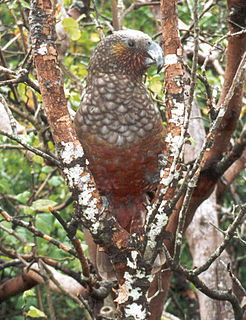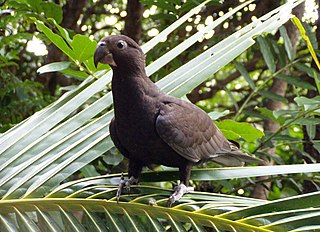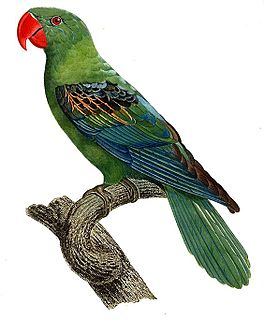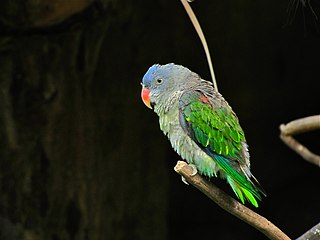
The family Psittacidae is one of three families of true parrots. It comprises the roughly 10 species of subfamily Psittacinae and 157 of subfamily Arinae, as well as several species that have gone extinct in recent centuries. Some of the most iconic birds in the world are represented here, such as the blue-and-gold macaw among the New World parrots and the grey parrot among the Old World parrots.

The genus Nestor is the type and only extant genus of the parrot family Nestoridae. Together with the kakapo, and the extinct parrots in the genus Nelepsittacus, they form the parrot superfamily Strigopoidea. The genus Nestor contains two extant parrot species from New Zealand and two extinct species from Norfolk Island and Chatham Island, New Zealand, respectively. All species are large stocky birds with short squarish tails. A defining characteristic of the genus is the tongue, which is tipped with a hair-like fringe. The superficial resemblance of this tongue to that of lorikeets has led some taxonomists to consider the two groups closely related, but DNA evidence shows they are not.

The true parrots are about 350 species of colorful flighted hook-billed, mostly herbivorous birds forming the superfamily Psittacoidea, one of the three superfamilies in the biological order Psittaciformes (parrots). True parrots are widespread, with species in Mexico, Central and South America, sub-Saharan Africa, India, Southeast Asia, Australia, and eastwards across the Pacific Ocean as far as Polynesia. The true parrots include many of the familiar parrots including macaws, conures, lorikeets, eclectus, Amazon parrots, grey parrot, and budgerigar.

Loriini is a tribe of small to medium-sized arboreal parrots characterized by their specialized brush-tipped tongues for feeding on nectar of various blossoms and soft fruits, preferably berries. The species form a monophyletic group within the parrot family Psittacidae. The group consist of the lories and lorikeets. Traditionally, they were considered a separate subfamily (Loriinae) from the other subfamily (Psittacinae) based on the specialized characteristics, but recent molecular and morphological studies show that the group is positioned in the middle of various other groups. They are widely distributed throughout the Australasian region, including south-eastern Asia, Polynesia, Papua New Guinea, Timor Leste and Australia, and the majority have very brightly coloured plumage.

Loriinae is a subfamily of psittacine birds, one of the five subfamilies that make up the family Psittaculidae. It consists of three tribes, the lories and lorikeets (Loriini), the budgerigar (Melopsittacini) and the fig parrots (Cyclopsittini), which are small birds, mostly of bright colors and inhabitants of Oceania and the islands of Southeast Asia.

Members of the parrot genus Psittacula or Afro-Asian ring-necked parakeets as they are commonly known in aviculture originates found from Africa to South-East Asia. It is a widespread group, with a clear concentration of species in south Asia, but also with representatives in Africa and the islands of the Indian Ocean. This is the only genus of Parrot which has the majority of its species in continental Asia. Of all the extant species only Psittacula calthropae, Psittacula caniceps and Psittacula echo do not have a representative subspecies in any part of mainland continental Asia. The rose-ringed parakeet, Psittacula krameri, is one of the most widely distributed of all parrots.

The greater vasa parrot is one of two species of vasa parrot, the other being the lesser vasa parrot C. nigra. The greater vasa parrot can be found throughout Madagascar and the Comoros.

The vasa parrots (Coracopsis) are three species of parrot which are endemic to Madagascar and other islands in the western Indian Ocean. Some taxonomists place the genus in Mascarinus.

The lesser vasa parrot or black parrot is a black coloured parrot native to Comoros, Madagascar, Mayotte, and Seychelles. It is one of two species of vasa parrots, the other being the greater vasa parrot C. vasa; although, the subspecies C. n. barklyi, of the Seychelles, is sometimes split as a third species, the Seychelles black parrot.

The Seychelles parakeet or Seychelles island parrot is an extinct species of parrot that was endemic to the Seychelles group in the Indian Ocean. It resembled the Alexandrine parakeet, but was smaller and lacked the pink colour in its collar. The species is suspected to have become extinct due to intense persecution by farmers and coconut plantation owners.

Described by French naturalist Anselme Gaëtan Desmarest in 1826, the genus Calyptorhynchus has two species of cockatoos. They are all mostly black in colour, and the taxa may be differentiated partly by size and partly by small areas of red, grey, and yellow plumage, especially in the tail feathers. Studies based on the mitochondrial DNA 12S gene fragment suggested that other sexually dichromatic species, the gang-gang cockatoo and the cockatiel may be the closest living relatives of Calyptorhynchus. However, subsequent studies, including more genes confirm the morphological taxonomy with the gang-gang cockatoo most closely related to the galah, within the white cockatoo group, and with the cockatiel as a third distinct subfamily of cockatoos.

The neotropical parrots or New World parrots comprise about 150 species in 32 genera found throughout South and Central America, Mexico, and the Caribbean islands, and two species formerly inhabited North America. They are also present on a few Pacific islands such as the Galápagos. Among them are some of the most familiar and iconic parrots, including the blue and gold macaw, sun conure, and yellow-headed amazon.

The Mascarene parrot or mascarin is an extinct species of parrot that was endemic to the Mascarene island of Réunion in the western Indian Ocean. The taxonomic relationships of this species have been subject to debate; it has historically been grouped with either the Psittaculini parrots or the vasa parrots, with the latest genetic study favouring the former group.

Psittacinae is a subfamily of Afrotropical or Old World parrots, native to sub-Saharan Africa, which include twelve species and two extant genera. Among the species is the iconic grey parrot.

Alisterus is a genus of medium-sized Australasian parrots, comprising the Australian king parrot, the Papuan king parrot and the Moluccan king parrot. The three species are respectively found in eastern Australia, Papua, the Moluccas and other Indonesian islands. Predominantly of red and green plumage, the long-tailed parrots are related to the genera Aprosmictus and Polytelis.

Tanygnathus is a genus of parrots in the Psittaculini tribe, of the superfamily of Psittacoidea.

Psittinus is a genus of parrot in the family Psittaculidae. It is usually considered to include a single species, the blue-rumped parrot, but the large subspecies P. c. abbotti is sometimes elevated to species rank as the Simeulue parrot. While long considered part of Psittacula, a 2019 genetic analysis supported reclassifying both species under their own genus Psittinus.

Parrots, also known as psittacines, are birds of the roughly 398 species in 92 genera comprising the order Psittaciformes, found mostly in tropical and subtropical regions. The order is subdivided into three superfamilies: the Psittacoidea, the Cacatuoidea (cockatoos), and the Strigopoidea. One-third of all parrot species are threatened by extinction, with higher aggregate extinction risk than any other comparable bird group. Parrots have a generally pantropical distribution with several species inhabiting temperate regions in the Southern Hemisphere, as well. The greatest diversity of parrots is in South America and Australasia.

The parrot subfamily Psittaculinae consists of three tribes, the Polytelini with three genera, the Psittaculini or Asian psittacines, and the pygmy parrots of the Micropsittini tribe.

















